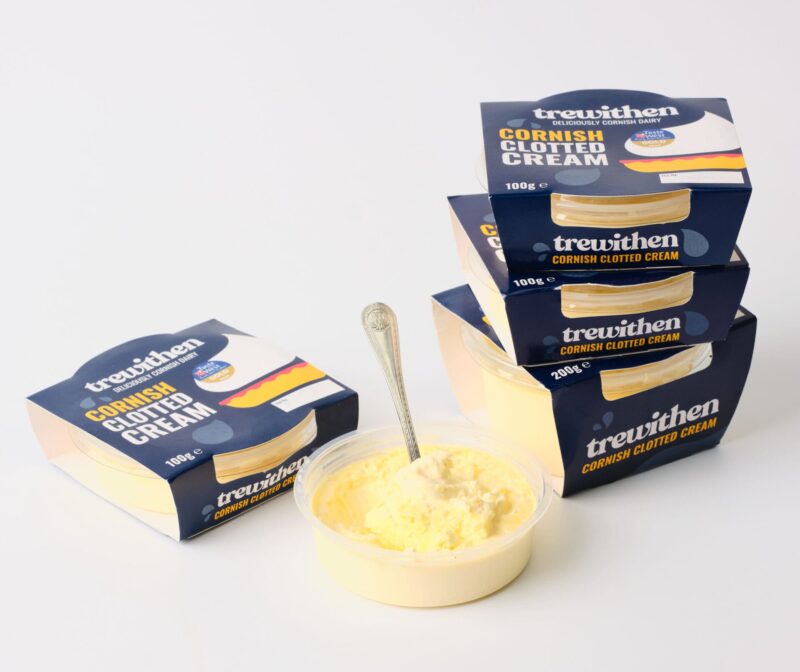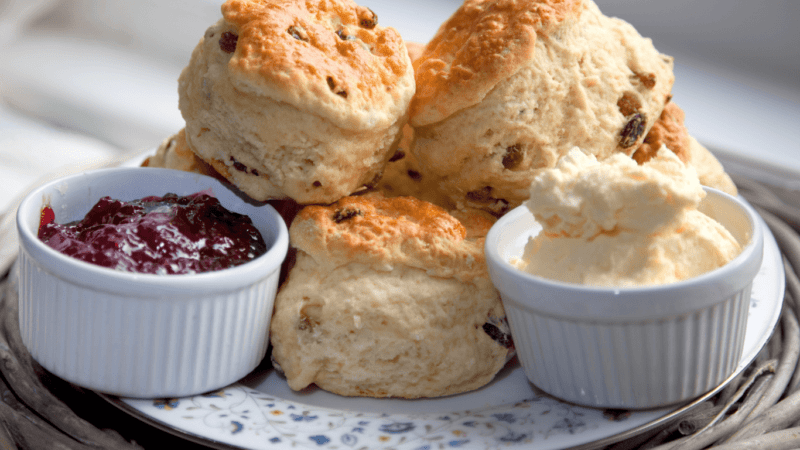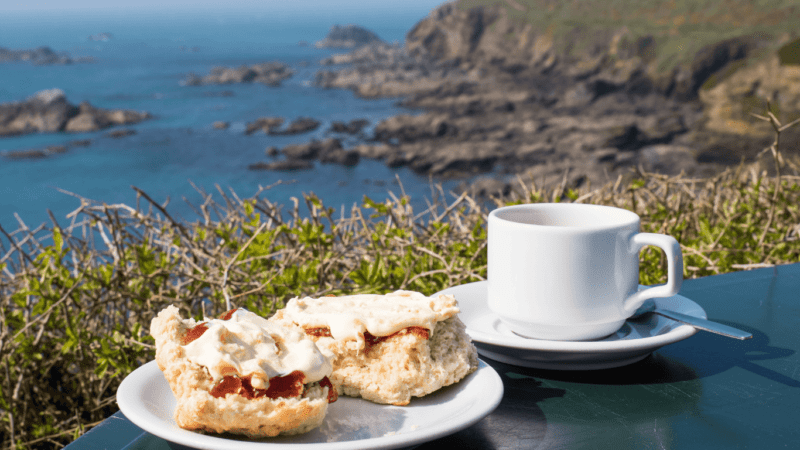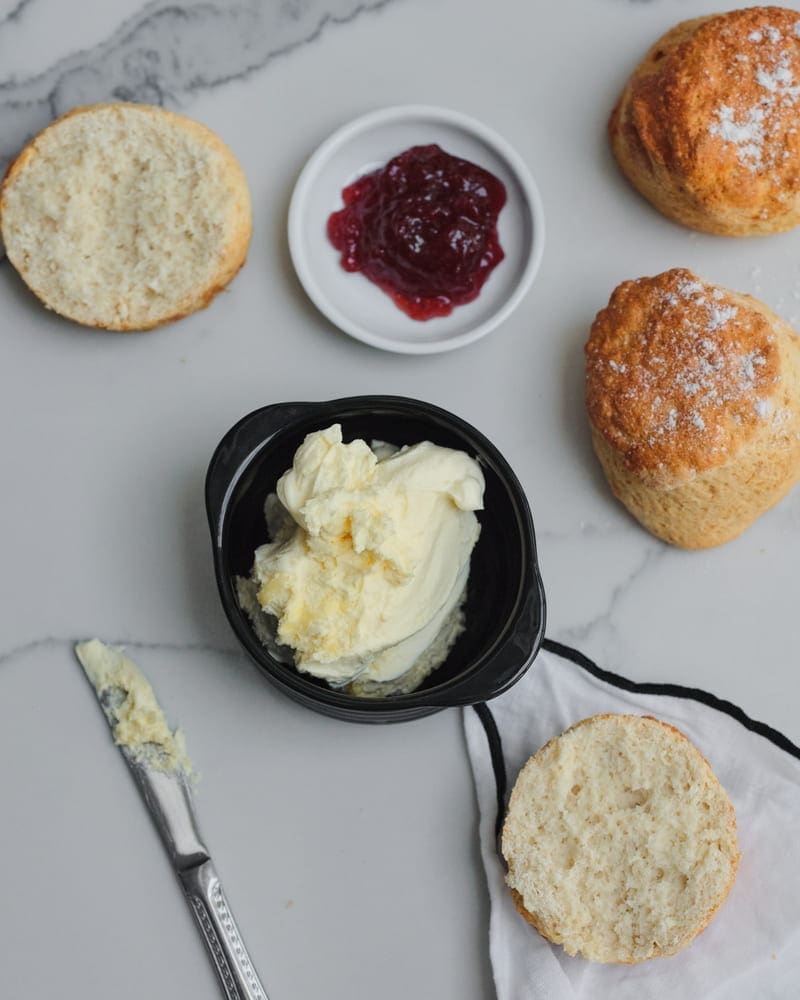The History of National Cream Tea Day
National Cream Tea Day celebrates one of Britain’s most cherished culinary traditions – the cream tea. Falling on the last Friday in June each year, this joyful occasion honours the simple yet sublime combination of freshly baked scones, Cornish clotted cream, and strawberry jam, all accompanied by a proper pot of tea.
Table of Contents
How the Celebration Began
The British have long adored tea and scones, but where did the cherished tradition of cream teas begin? Some trace its origins to the 11th century in Tavistock Abbey in Devon, while others believe it flourished much later. By the mid-19th century, as railways made travel to Devon and Cornwall easier, visitors seeking fresh sea air discovered a local delight: warm scones topped with thick clotted cream and sweet jam. And so, the modern cream tea was born.
National Cream Tea Day celebrates the tradition of the cream tea while supporting charitable causes – it has helped raise over £2 million for charities across the UK to date. The perfect excuse to indulge in a quintessentially British treat whilst doing something good!
The Great Cream Debate: Cornwall vs Devon
Did you know the Queen once tried to settle the age-old debate over whether cream or jam should go first on a scone? In Devon, they argue that cream should be spread first. The Cornish, however, insist that jam comes first to keep the cream from melting on a warm scone. But not even royal influence could resolve this delicious dispute and it still rages on with both sides of the Tamar claiming their way is the right way.

When is National Cream Tea Day 2025?
Mark your calendars, National Cream Tea Day is on Friday, 27th June 2025! If you love a good cream tea, this is your day to indulge. So, clear your schedule and forget the rest of your shopping list, because the only thing that matters is a proper afternoon tea with scones, jam, and a generous dollop of Trewithen clotted cream. Let’s be honest, this is one celebration you don’t want to miss.
Celebrating National Cream Tea Day in Cornwall
Cornish residents take great pride in making their cream teas the right way. Every year, this beloved tradition is celebrated everywhere, from cosy living room coffee tables to charming cafés across the county. Craving a delicious cream tea but not sure where to go? Don’t worry – the Cream Tea Society has you covered with its handy Cream Tea Finder. And just when you thought it couldn’t get any better, many cafés across Cornwall ensure a steady supply of Trewithen clotted cream.
Local Events and Activities
One of the best things about cream teas? You can enjoy them anywhere. Whether it’s in the garden on a sunny day or at a café with friends, there’s no wrong way to indulge in this British classic. But National Cream Tea Day isn’t just about delicious treats, it’s also about giving back.
The Cream Tea Society encourages people to support a charity of their choice, making the celebration as meaningful as it is tasty. The more recognition the event receives, the greater the chance of raising funds for good causes. So, on National Cream Tea Day, don’t forget to share your love for cream teas on social media using #NationalCreamTeaDay. Because after all, the best traditions are the ones we enjoy together.

How to Create the Perfect Cream Tea
The perfect setting is vital when preparing the perfect cream tea- china teaware, cloth napkins, and perhaps a garden view for that quintessential English afternoon indulgence.
Choosing Your Cornish Clotted Cream
At Trewithen Dairy, we’ve got you covered. Our award-winning real clotted cream is a cut above the rest and crowned with an unmistakable golden crust. No wonder it claimed the prestigious 2025 Taste of the West Gold Award! And the best part? Its rich, velvety texture and indulgent flavour go far beyond warm scones and a cup of tea. Use it in countless clotted cream recipes for a truly decadent touch.
Home-Baked Scones Recipe
At Trewithen Dairy, we’ve done the tasting and testing, so you don’t have to. With time, care, and plenty of trial and error, we’ve perfected a selection of recipes that showcase the rich flavour of our Cornish milk ingredients. Here is a traditional homebaked scone recipe which gets our tastebuds excited time and time again
- 350g self-raising flour (plus more for dusting)
- 1 tsp baking powder
- 85g butter, cut into cubes
- 3 tbsp caster sugar
- 175ml milk
- 1 tsp vanilla extract
- A squeeze of lemon juice
- A beaten egg to glaze
- jam and clotted cream to serve
1. Heat the oven to 220C/200C fan/gas 7. Tip the self-raising flour into a large bowl with ¼ tsp salt and the baking powder, then mix.
2. Add the butter, then rub it in with your fingers until the mix looks like fine crumbs. Stir in the caster sugar.
3. Put the milk into a jug and heat in the microwave for about 30 seconds until warm, but not hot. Add the vanilla extract and a squeeze of lemon juice, then set aside for a moment.
4. Put a baking tray in the oven. Make a well in the dry mix, then add the liquid and combine it quickly with a cutlery knife – it will seem pretty wet at first.
5. Scatter some flour onto the work surface and tip the dough out. Dredge the dough and your hands with a little more flour, then fold the dough over 2-3 times until it’s a little smoother. Pat into a round about 4cm deep. Take a 5cm cutter (smooth-edged cutters tend to cut more cleanly, giving a better rise) and dip it into some flour. Plunge into the dough, then repeat until you have four scones. You may need to press what’s left of the dough back into a round to cut out another four.
6. Brush the tops with a beaten egg, then carefully arrange on the hot baking tray. Bake for 10 mins until risen and golden on the top. Eat it warm or cold on the day of baking, generously topped with jam and clotted cream. If freezing, freeze once cool. Defrost, then put in a low oven (about 160C/140C fan/gas 3) for a few minutes to refresh.
Picking Your Preserves
The right jam can make all the difference in a cream tea. While strawberry jam is the traditional favourite, with its perfect sweet-tart balance, raspberry or blackcurrant are equally delicious alternatives.

Behind the Scenes at Trewithen Dairy
Trewithen Dairy has been crafting quality dairy products since 1994. Over the years, we’ve poured our heart and soul into perfecting every step of our production. As proud caretakers of the land, we and our farmers understand the importance of protecting the environment for future generations. That’s why we champion regenerative farming, a sustainable approach that helps preserve and nourish the land for years to come.
How We Make Cornwall’s Best Clotted Cream
At Trewithen Dairy, we follow time-honoured Cornish traditions to craft the richest, creamiest clotted cream. It starts with the finest local milk, gently heated slowly over hours to allow the natural golden crust to form, an unmistakable sign of true Cornish quality. But the real secret? We believe it lies in the way we care for our cows and our
Trew Farming Standards.
FAQs
Do Cornish put jam or cream first?
In Cornwall, it’s always jam first, then clotted cream! This tradition isn’t just about heritage, it’s about taste and texture. Spreading jam first ensures a smooth, even layer, allowing the thick, velvety clotted cream to sit proudly on top without melting. This way, you get the full richness and depth of flavour in every bite.
Do you split a scone or cut it?
Traditionally, scones should be broken apart by hand, not cut with a knife. This preserves their light, fluffy texture and prevents unnecessary crumbling. Cutting a scone can sometimes compress the delicate layers, making it denser. By gently pulling it apart, you ensure a perfect base for a generous dollop of jam and Trewithen Dairy’s clotted cream, just the way a proper cream tea should be enjoyed!
What is the difference between Devon and Cornwall cream tea?
The great cream tea debate comes down to one key difference:
- Cornish cream tea = Jam first, then clotted cream
(as it should be!). - Devon cream tea = Clotted cream first, then jam
(controversial but loved in Devon!).
Cornish clotted cream is often thicker, creamier, and more indulgent, thanks to its slow-baked production process, which creates the signature golden crust.
